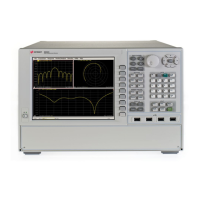4-32 Service Guide N5227-90001
Troubleshooting PNA Series Microwave Network Analyzers
Measurement System Troubleshooting N5227A
5. If the observed problem was frequency banded rather than broadband related, set the analyzer frequency
to the center of the problem band. The spectrum analyzer should measure a signal above the network
analyzer setting. For analyzers with DSP version 4.0, the signal is 7.61 MHz above the network analyzer
setting. For analyzers with DSP version 5.0, the signal is 7.44 MHz above the network analyzer setting.
6. If the LO signal is not present but the 50 MHz reference signal from “Checking the A14 50 MHz
Reference Outputs” is present, replace the A15 LO synthesizer board. Refer to “Removing and Replacing
the A4–A17 Boards” on page 7-10.
7. If the signal is present, reconnect cable W41, and then continue with “Checking the A25 HMA26.5
Output”.
Checking the A25 HMA26.5 Output
1. Refer to the block diagram at the end of this chapter and to “Bottom RF Cables, Standard 4-Port
Configuration, Option 400” on page 6-46. Locate the flexible cable W52 at the A25 HMA26.5.
2. Disconnect W52 (4-port models) or W80 (2-port models) from the A25 HMA 26.5.
3. Connect the spectrum analyzer to the open connector on the A25 HMA 26.5.
4. Refer to the IMPORTANT notice on page 4-23. Set the network analyzer for an 800 MHz CW frequency
and observe the spectrum analyzer measurement. For analyzers with DSP version 4.0, an 807.61 MHz
signal should be present. For analyzers with DSP version 5.0, an 807.44 MHz signal should be present.
5. If the observed problem was frequency banded rather than broadband related, set the analyzer frequency
to the center of the problem band. The spectrum analyzer should measure a signal above the network
analyzer setting. For analyzers with DSP version 4.0, the signal is 7.61 MHz above the network analyzer
setting. For analyzers with DSP version 5.0, the signal is 7.44 MHz above the network analyzer setting.
6. If the signal is not present but the signal from “Checking the A15 13.5 GHz LO Synthesizer Output” is
present, replace the A25 HMA 26.5. Refer to “Removing and Replacing the A25 HMA26.5” on page 7-26.
7. If the signal is present, reconnect cable W52 or W80 and then:
• for 2-port models, continue checking with “Checking the Receiver Group” on page 4-40.
• for 4-port models, continue checking with “Checking the A26 Splitter Output”.
Checking the A26 Splitter Output
1. Refer to the block diagram at the end of this chapter and to “Bottom RF Cables, Standard 4-Port
Configuration, Option 400” on page 6-46. Locate the semi-rigid cables W53 and W54, at the A26 splitter.
2. Disconnect W53 and W54, one at a time, from the A26 splitter.
3. Connect the spectrum analyzer to the open connector.
4. Refer to the IMPORTANT notice on page 4-23. Set the network analyzer for an 800 MHz CW frequency
and observe the spectrum analyzer measurement. For analyzers with DSP version 4.0, an 807.61 MHz
signal should be present. For analyzers with DSP version 5.0, an 807.44 MHz signal should be present.
5. If the observed problem was frequency banded rather than broadband related, set the analyzer frequency
to the center of the problem band. The spectrum analyzer should measure a signal above the network
analyzer setting. For analyzers with DSP version 4.0, the signal is 7.61 MHz above the network analyzer
setting. For analyzers with DSP version 5.0, the signal is 7.44 MHz above the network analyzer setting.
6. If the signal is not present but the signal from “Checking the A25 HMA26.5 Output,” is present, replace

